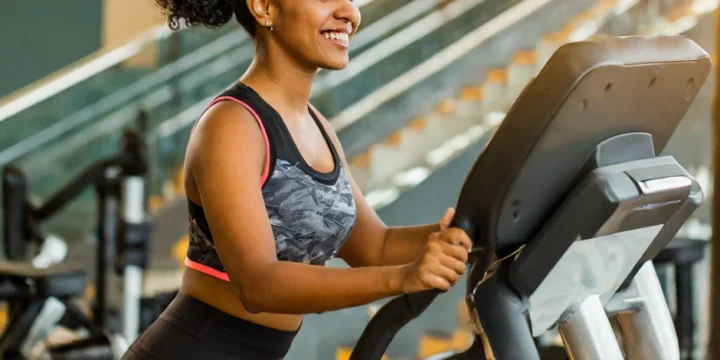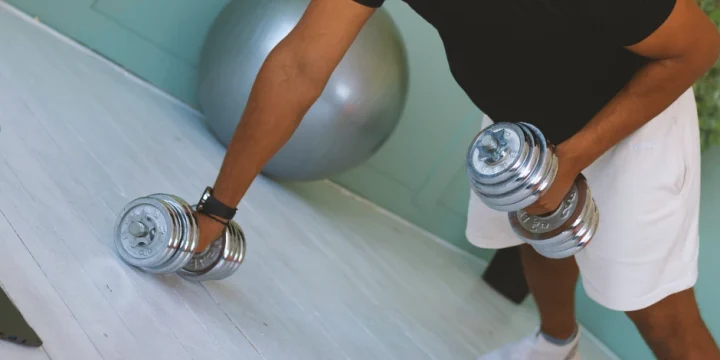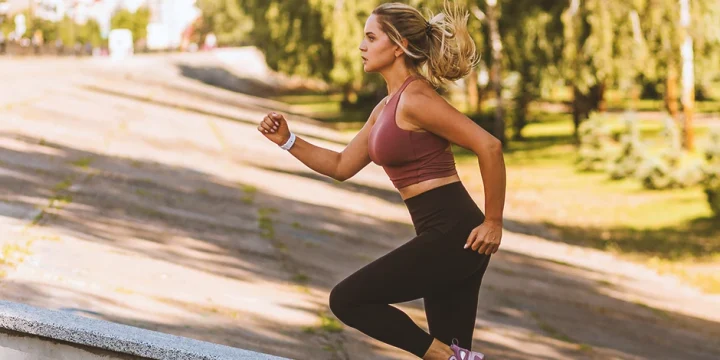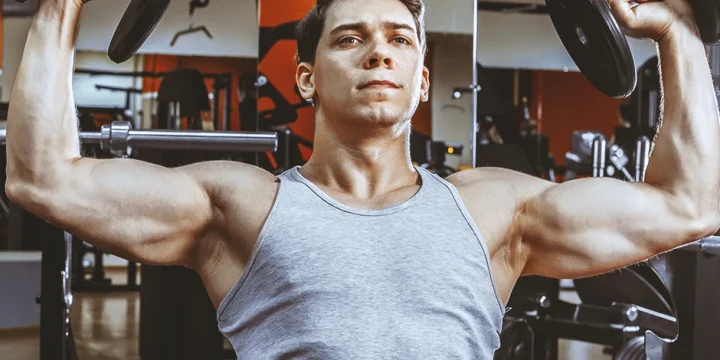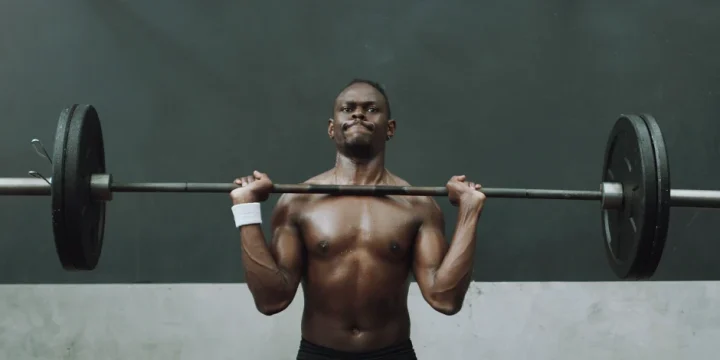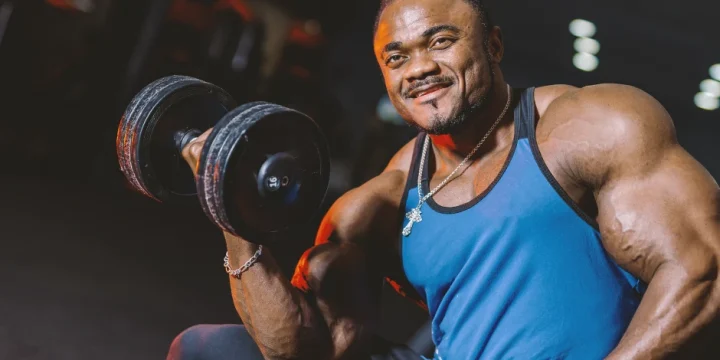Free weights are the best way to activate stabilizer muscles and make all exercises more functional.
They allow a greater range of motion at joints and help you build functional strength for the most significant carryover to real life.
That’s why you should read our guide on the 10 best adjustable kettlebells for home gym workouts.
I undertook 40 hours of research and pulled all the information I learned during my personal trainer career to compile the best workout routine using free weights.
After reading the article, you will have sufficient knowledge to implement all free-weight workouts into your weekly workout routine.
Quick Summary
- To build muscle and enhance functional strength, incorporate free weight-only workout routines that activate major muscle groups using equipment like dumbbells and kettlebells.
- These routines target key muscle groups, including legs, chest, back, shoulders, and arms, ensuring a full-body workout.
- According to the National Institute of Health, implementing the principle of progressive overload is essential to avoid plateauing and losing muscle mass or strength.
- As a personal trainer, I believe free-weight workouts are crucial for developing real-life functional strength and muscle coordination.
Workout Description

Below is information on the best exercises to target each major muscle group.
In my experience as a personal trainer, I've guided numerous fitness enthusiasts through free weight-only workout routines. These routines engage the entire body, effectively target specific muscles, and have been instrumental in building muscle through comprehensive full-body exercises.
Those parts include your arms, legs, chest, back, and shoulders.
You will also get information on the number of sets, reps, and rest intervals to guide you through the entire workout.
However, according to the National Institute of Health (NIH), you should incorporate the principle of progressive overload to avoid plateauing and losing muscle mass or strength [1].
"Kettlebell training promotes functionality. Full body training is efficient. And pairing them both together is an excellent way to maximize your workouts!"
- Josh England, Certified Personal Trainer
Freeweight-Only Workout #1 – Legs
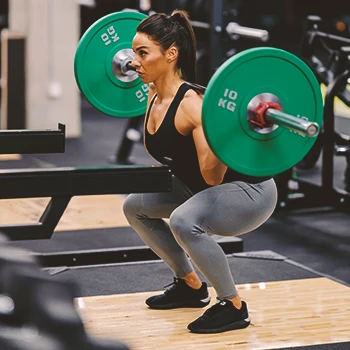
Legs are consistent with major muscle groups such as the quadriceps, glutes, and hamstrings.
Smaller muscles include calves, adductor muscles, and hip internal and external rotators.
Incorporate complex exercises into the dynamic warm-up to warm up for this leg session.
Dynamic warm-up has been proven in a study by NIH to effectively reduce injuries in athletes and normal people if performed before each intense workout [2].
Here is the entire workout to hit all leg muscles and induce maximal hypertrophy and strength-building effects:
- Back Squat - Back squats target the quadriceps, glutes, and hamstrings. Complete 5 sets of 4-6 reps and recover for up to 3 minutes before proceeding to the next set. This rep range and a number of sets target building lower body strength
- Romanian Deadlift - This exercise will target your posterior chain muscles, such as the hamstrings, glutes, and erector spinae. You should perform 4 sets of up to 10 reps and rest for 90 seconds in between the sets. This rep range and rest interval are the best for hypertrophy or muscle-building.
- Walking Lunge - Lunges are incredibly effective at targeting your adductors, quads, hams, and glutes. You should perform 4 sets of 8 reps for each leg. The rest interval should be between 60 and 90 seconds.
- Dumbbell Leg Curl - Dumbbell leg curls are excellent for isolating your three hamstring muscles, including biceps femoris, semitendinosus, and semimembranosus. Perform 3 sets of 12 to 15 reps and rest for 60 seconds between the sets.
- Single-leg Calf Raises - Unilateral calf raises are much more efficient than bilateral ones. You should hit all three feet directions, hitting 7 reps each and completing 3 sets. Don't rest more than 60 seconds between the sets.
- Tiptoe Farmer's Walk - This is a modified farmer's walk aiming to build isometric strength in your calves. Perform 3 sets of max distance walks and rest for up to 60 seconds between the sets.
Related: Best Free Weight Exercises: How-To, Benefits and More
Freeweight-Only Workout #2 – Chest
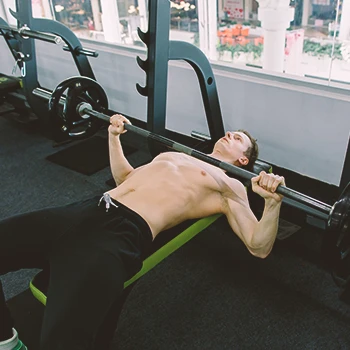
The chest workout focuses on developing close to one-third of the upper body.
According to NIH, the biggest chest muscle is the pectoralis major, which has three “streams” of fibers, meaning you will need to use different angles during lifting to hit each of them [3].
Lift heavy weights to build strength in your chest and upper body.
Lifting heavy weights is the only way to increase strength, but you should only lift heavy in the first two exercises (foundational, classic exercise), and the rest should be performed with lighter weights.
The 5-day dumbbell workout routine includes upper body exercises like the incline dumbbell bench press and targets each muscle group with exercises like the dumbbell sumo squat.
The strength training for the entire upper body should begin with compound and finish with isolation exercises, or the resistance should at least decrease throughout the workout.
This workout involves activating the middle, lower, and upper chest using flat and incline bench press exercises.
Here is the entire workout:
- Wide-grip bench press - this exercise is performed on a flat bench and is excellent for developing horizontal push maximal strength. To gain strength and build muscle, perform 5 sets of 3-5 reps and rest between 3-5 minutes.
- Incline dumbbell press - the starting position is on the incline bench, and this exercise is excellent for hitting upper chest fibers. Perform 8 reps for 4 to 5 sets and rest for 90 minutes to build the most significant amount of muscles.
- Dumbbell fly - flyes are excellent for widening your chest and making it look more aesthetic. Perform 8-12 reps of 3 sets and rest for 60-90 seconds.
- Dumbbell squeeze press - this exercise is excellent for making your chest thicker. Complete 12 reps for 3 sets and rest for 60 seconds.
- Push-ups - push-ups are excellent for including shoulder blades in the whole horizontal pressing motion. Perform 3 sets of 12 reps and rest for less than 60 seconds in between.
Freeweight-Only Workout #3 – Back
The biggest back muscles include the latissimus dorsi, trapezius, and erector spinae.
The first two build most of the upper back, while the last work more during the lower body exercises.
Here is the entire back workout:
- Deadlift - lift the barbell until standing upright, and avoid using heavier weights until you perfect the deadlift technique. Complete 3-5 reps for 5 sets and rest for 3 to 5 minutes.
- Weighted Pull-up - hanging from the recommended pull-up bar, lift your chin above the bar without leaning forward. Perform 4-6 reps for 4 sets and rest for 90 seconds.
- Single-arm Row - lean forward on your front foot and row the dumbbell towards your hips. Complete 6 reps with each hand for 3 sets and rest for 90 seconds.
- Pendlay Row - perform 12 reps for 3 sets and rest for about 60 seconds.
- Dumbbell Shrug - perform 12-15 reps for 3 sets and rest for as little as possible between the sets.
Freeweight-Only Workout #4 – Shoulders
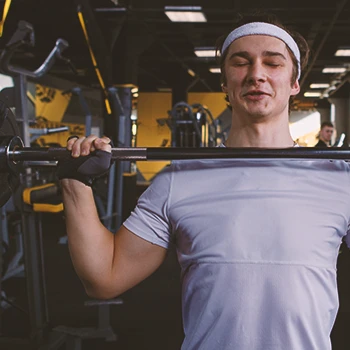
In my role as a personal trainer, I always emphasize the importance of variety in shoulder workouts to my clients to prevent plateauing.
We focus on the key shoulder muscles - the anterior, lateral, and posterior deltoid - which together form the significant deltoid head, ensuring a comprehensive approach to shoulder development.
You should overload the barbell or dumbbell version of the overhead press/push-press exercise to gain the most significant strength.
Here is the entire shoulder workout:
- Barbell Push-press - this is a variation of the overhead barbell press, but more explosive. Perform 5 sets of 4-6 reps and rest for 2-3 minutes.
- Arnold Press - this press variation is effective for building your lateral and anterior deltoid. You should complete 4 sets of 6 to 8 reps and rest no more than 90 seconds to achieve the best hypertrophy results.
- Dumbbell Side Raise - lateral raises are performed with just a pair of dumbbells. Complete 10 to 12 reps for 3 sets and rest for 60 to 90 seconds.
- Reverse Fly - reverse fly is an excellent exercise for building the posterior deltoid. You should perform 3 sets of 12 reps and rest for 60 seconds between the sets.
- Upright Row - upright rows will challenge your lateral deltoids and trapezius muscles. Complete 3 sets of up to 15 reps and rest for 60 seconds between the sets.
Freeweight-Only Workout #5 – Arms
When talking about arm muscles, we refer to triceps brachii, biceps brachii, brachialis, radio brachialis, and coracobrachialis.
Here is the entire arm workout:
- Barbell Curl - complete 3 sets of 6 to 8 reps and rest for 90 seconds in between.
- Triceps Dips - perform 3 sets of 6 to 8 reps and rest no more than 90 seconds.
- Hammer Curl - you should do up to 12 reps for 3 sets and rest between 60 and 90 seconds.
- Skull Crusher - you should complete 12 reps for 3 sets and rest for 60 seconds.
- Concentration Curl - complete up to 15 reps for 3 sets and rest as little as possible.
- Dumbbell Kickback - perform 15 reps for 3 sets and rest for as little as possible.
Recovery and Nutrition Tips for Free Weight Training
For optimal recovery and results from free weight training, prioritize these tips:
- Protein Intake: Consume adequate protein (1.2-2.0 grams per kg of body weight) daily for muscle repair. Include lean meats, dairy, or plant-based options like tofu.
- Carbohydrates: Refuel with complex carbs like whole grains and vegetables for energy replenishment.
- Hydration: Stay well-hydrated to aid muscle recovery and overall function.
- Sleep: Aim for 7-9 hours of quality sleep for muscle growth and hormonal balance.
- Active Recovery: Engage in light activities like walking or yoga on rest days to promote circulation.
- Stretching: Incorporate regular stretching or foam rolling to reduce muscle tightness and enhance flexibility.
- Omega-3 Fatty Acids: Include sources like fish or flaxseeds to combat inflammation.
- Post-Workout Nutrition: Have a balanced meal or snack with protein and carbs within 45 minutes after training to aid recovery.
- Rest Days: Schedule regular rest days to allow muscles to repair and grow.
- Mindfulness Practices: Engage in stress-reducing activities like meditation to support overall wellbeing.
FAQs
Is Free Weights Harder Than Machines?
Yes, free weights are harder than machines. For instance, dumbbell exercises are harder because your joints need to be stabilized during the whole movement, which requires a substantial activation of stabilizer muscles.
Can You Get Ripped With Free Weights?
Yes, you can get ripped with free weights. Free weights are as effective as machines for getting ripped, meaning the diet will play the most significant part in your journey to lose fat and get ripped.
What Are the Big 3 Free Weight Exercises?
The big three free weight exercises are dumbbell bench press, dumbbell squats, and bilateral dumbbell deadlifts. However, rear foot elevated split squats, overhead presses, and similar exercises are as effective as the previous ones for gaining muscle mass.
References:
- https://www.ncbi.nlm.nih.gov/pmc/articles/PMC4215195/
- https://www.ncbi.nlm.nih.gov/pmc/articles/PMC9140806/
- https://www.ncbi.nlm.nih.gov/pmc/articles/PMC5504579/
About The Author
You May Also Like
